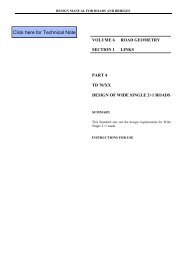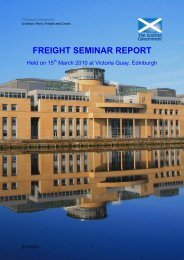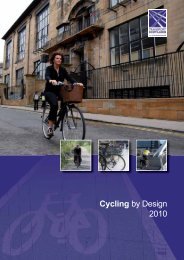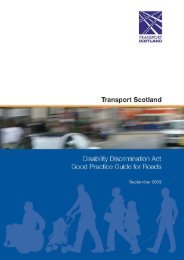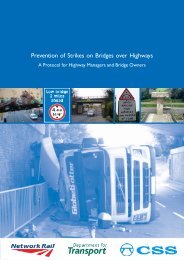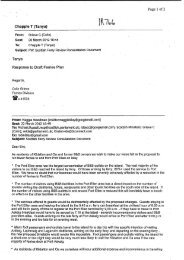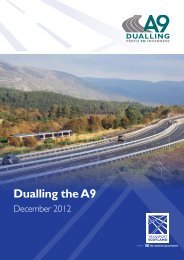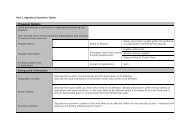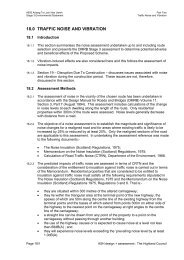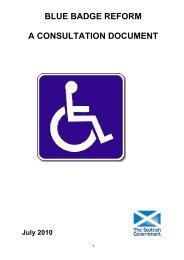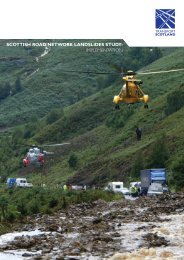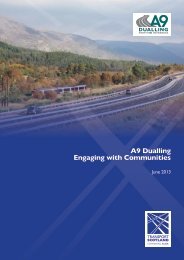Public Transport Model Calibration and Validation Report
Public Transport Model Calibration and Validation Report
Public Transport Model Calibration and Validation Report
Create successful ePaper yourself
Turn your PDF publications into a flip-book with our unique Google optimized e-Paper software.
L<strong>and</strong>-Use <strong>and</strong> <strong>Transport</strong><br />
Integration in Scotl<strong>and</strong> (LATIS)<br />
TMfS:07 National <strong>Public</strong> <strong>Transport</strong> <strong>Model</strong><br />
<strong>Calibration</strong> <strong>and</strong> <strong>Validation</strong> <strong>Report</strong><br />
<strong>Report</strong> for <strong>Transport</strong> Scotl<strong>and</strong><br />
October 2009
Document Control<br />
Project Title:<br />
MVA Project Number:<br />
Document Type:<br />
Directory & File Name:<br />
TMfS:07<br />
C3713602<br />
<strong>Report</strong><br />
H:\Contracts\Live\C3713600_Tmfs Update\<strong>Report</strong>\PT <strong>Report</strong>s\2 PT<br />
<strong>Calibration</strong> And <strong>Validation</strong> <strong>Report</strong>\V5 - Oct09\C37136_Tmfs07 National PT<br />
<strong>Model</strong> Cal Val <strong>Report</strong> V5.Doc<br />
Document Approval<br />
Primary Author:<br />
Other Author(s):<br />
Reviewer(s):<br />
Formatted by:<br />
Andrew Bagnall<br />
Gordon Scott<br />
David Connolly, Jeff Davidson, Kevin Lumsden<br />
Nicola Milne<br />
Distribution<br />
Issue Date Distribution Comments<br />
1 26/01/09 David Connolly Draft for Internal Review<br />
2 30/01/09 <strong>Transport</strong> Scotl<strong>and</strong><br />
TTAA<br />
3 11/05/09 <strong>Transport</strong> Scotl<strong>and</strong><br />
TTAA<br />
4 05/10/09 <strong>Transport</strong> Scotl<strong>and</strong><br />
First release version (for TS/TAA<br />
review/comment)<br />
Second release version (for TS/TAA<br />
review/comment)<br />
Draft Final <strong>Report</strong><br />
TTAA<br />
5 28/10/2009 General Release via LATIS<br />
Website<br />
Final <strong>Report</strong>
Contents<br />
1 Introduction i<br />
1.1 Overview 1.1<br />
1.2 Structure of this <strong>Report</strong> 1.1<br />
2 Assignment <strong>Model</strong> 2.1<br />
2.1 Assignment <strong>Model</strong> Inputs 2.1<br />
2.2 Path Building <strong>and</strong> Loading 2.1<br />
2.3 Crowding 2.2<br />
2.4 Bus Speed Factors 2.3<br />
2.5 Assignment <strong>Model</strong> Parameters 2.4<br />
2.6 Wait Curves 2.5<br />
2.7 Fares <strong>Model</strong> 2.6<br />
3 <strong>Model</strong> <strong>Validation</strong> 3.1<br />
3.1 Introduction 3.1<br />
3.2 Passenger Loading Comparisons 3.1<br />
3.3 Rail Passenger Boarding / Alighting Comparisons 3.8<br />
3.4 Rail Capacities 3.8<br />
3.5 Comparison of Timetabled <strong>and</strong> <strong>Model</strong>led Bus Journey Times 3.9<br />
4 Conclusions <strong>and</strong> Recommendations 4.1<br />
4.1 Summary 4.1<br />
4.2 <strong>Validation</strong> 4.1<br />
4.3 Recommendations 4.2<br />
Tables<br />
Table 2.1 PDFH Non-London Commuting Rail Crowding 2.3<br />
Table 2.2 <strong>Public</strong> <strong>Transport</strong> Assignment <strong>Model</strong> Parameters 2.5<br />
Table 2.3 Wait Times 2.6<br />
Table 2.4 Rail Fares (2007 prices) 2.7<br />
Table 2.5 Bus Fares (2007 prices) 2.8<br />
Table 2.6 Ferry Fares (2007 prices) 2.9<br />
Table 3.1 Summary of PT Cal Val – Cordons Screenlines 3.2<br />
Table 3.2 Summary of PT Cal Val – Individual Sites 3.2<br />
Table 3.3 Inbound Aberdeen Cordon 3.3<br />
Table 3.4 Outbound Aberdeen Cordon 3.3<br />
Table 3.5 Inbound Dundee Cordon 3.4<br />
Table 3.6 Outbound Dundee Cordon 3.4<br />
Table 3.7 Inbound Edinburgh Cordon 3.5<br />
Table 3.8 Outbound Edinburgh Cordon 3.5<br />
Table 3.9 Inbound Glasgow Cordon 3.6<br />
Table 3.10 Outbound Glasgow Cordon 3.6<br />
TMfS:07 National <strong>Public</strong> <strong>Transport</strong> <strong>Model</strong> <strong>Calibration</strong> <strong>and</strong> <strong>Validation</strong> <strong>Report</strong> 1
Contents<br />
Table 3.11 Inbound Inverness Cordon 3.7<br />
Table 3.12 Outbound Inverness Cordon 3.7<br />
Table 3.13 Boarding/Alighting Summary 3.8<br />
Table 3.14 Journey Time <strong>Validation</strong> 3.9<br />
Figures<br />
Figure 1.1 Overview of the TMfS <strong>Model</strong> Hierarchy – National PT <strong>Model</strong> Interaction 1.1<br />
Figure 3.1 Timetable versus <strong>Model</strong>led Bus Journey Times 3.10<br />
Appendices<br />
A<br />
B<br />
C<br />
D<br />
E<br />
Bus <strong>and</strong> Rail Count Locations<br />
Passenger Loading Comparisons<br />
Rail Passenger / Alighting Comparisons<br />
<strong>Model</strong>led Rail Loadings versus Capacities<br />
Timetabled <strong>and</strong> <strong>Model</strong>led Bus Journey Time Comparisons<br />
TMfS:07 National <strong>Public</strong> <strong>Transport</strong> <strong>Model</strong> <strong>Calibration</strong> <strong>and</strong> <strong>Validation</strong> <strong>Report</strong> 2
Background<br />
LATIS Commission – Development of <strong>Model</strong>ling Framework<br />
In August 2006 <strong>Transport</strong> Scotl<strong>and</strong> commissioned MVA Consultancy to a Term Commission<br />
for the maintenance <strong>and</strong> enhancement of the <strong>Transport</strong> <strong>Model</strong> for Scotl<strong>and</strong> (TMfS) <strong>and</strong> the<br />
accompanying <strong>Transport</strong>, Economic <strong>and</strong> L<strong>and</strong>-use <strong>Model</strong> of Scotl<strong>and</strong> (TELMoS).<br />
A central element of the Commission was to develop <strong>and</strong> deliver an enhanced 2007-based<br />
l<strong>and</strong>-use <strong>and</strong> transport modelling system. MVA proposed a hierarchical modelling<br />
framework, with a single National Strategic Travel dem<strong>and</strong> <strong>and</strong> L<strong>and</strong> Use <strong>Model</strong>ling<br />
framework as the upper tier, Regional Travel Dem<strong>and</strong> <strong>Model</strong>s as the mid-tier <strong>and</strong> detailed<br />
local models (eg microsimulation) as the lower tier. The National <strong>Model</strong>ling Framework has<br />
now been developed. It incorporates a number of technical enhancements <strong>and</strong> new <strong>and</strong><br />
more robust data <strong>and</strong> will, in time, replace its predecessor, TMfS/TELMoS:05.<br />
On 6 November 2008, the TMfS Term Commission changed its name to L<strong>and</strong>-Use <strong>and</strong><br />
<strong>Transport</strong> Integration in Scotl<strong>and</strong> (LATIS). The service is provided by <strong>Transport</strong> Scotl<strong>and</strong><br />
<strong>and</strong> their supporting consultants <strong>and</strong> offers a wide range of support <strong>and</strong> technical advice.<br />
The LATIS service currently includes four distinct elements, as follows:<br />
• a user engagement programme, consultations, discussions <strong>and</strong> advice on a range of<br />
transport <strong>and</strong> travel planning issues;<br />
• the collection <strong>and</strong> provision of l<strong>and</strong>-use planning data;<br />
• the collection of transport data through the use of the Data Collection Contract; <strong>and</strong><br />
• a travel dem<strong>and</strong> <strong>and</strong> l<strong>and</strong>-use modelling suite.<br />
The TMfS:07 <strong>and</strong> TELMoS:07 models are designed to deliver the fourth of these elements.<br />
TMfS:07 & TELMoS:07 <strong>Model</strong> <strong>Report</strong>s<br />
This report describes the development of the TMfS:07 National Road <strong>Model</strong> <strong>and</strong> is one of a<br />
series of eight documents describing the construction, calibration <strong>and</strong> validation of the<br />
TMfS:07 <strong>and</strong> TELMoS:07 models, as shown below:<br />
TMfS:07 National Travel Dem<strong>and</strong> <strong>Model</strong><br />
1. TMfS:07 Dem<strong>and</strong> <strong>Model</strong> Development <strong>Report</strong>.<br />
TMfS:07 National Road <strong>Model</strong><br />
2. TMfS:07 National Road <strong>Model</strong> Development <strong>Report</strong>; <strong>and</strong><br />
3. TMfS:07 National Road <strong>Model</strong> <strong>Calibration</strong> & <strong>Validation</strong> <strong>Report</strong>.<br />
TMfS:07 National <strong>Public</strong> <strong>Transport</strong> <strong>Model</strong><br />
4. TMfS:07 National <strong>Public</strong> <strong>Transport</strong> <strong>Model</strong> Development <strong>Report</strong>; <strong>and</strong><br />
5. TMfS:07 National <strong>Public</strong> <strong>Transport</strong> <strong>Model</strong> <strong>Calibration</strong> <strong>and</strong> <strong>Validation</strong> <strong>Report</strong>.<br />
TELMoS:07 National L<strong>and</strong> Use <strong>Model</strong><br />
6. TELMoS:07 <strong>Model</strong> Description <strong>Report</strong>;<br />
7. TELMoS:07 Assembly of Planning Policy Inputs; <strong>and</strong><br />
8. TELMoS:07 <strong>Model</strong> Demonstration <strong>Report</strong>.<br />
TMfS:07 National <strong>Public</strong> <strong>Transport</strong> <strong>Model</strong> <strong>Calibration</strong> <strong>and</strong> <strong>Validation</strong> <strong>Report</strong><br />
i
1 Introduction<br />
1.1 Overview<br />
1.1.1 The National <strong>Public</strong> <strong>Transport</strong> <strong>Model</strong> forms part of the overall 2007 TMfS model hierarchy<br />
(illustrated in Figure 1.1). It is a strategic model which has been prepared with a level of<br />
detail commensurate with appraising national policy <strong>and</strong> strategic l<strong>and</strong>-use <strong>and</strong> transport<br />
interventions <strong>and</strong> providing a key source of transport supply <strong>and</strong> dem<strong>and</strong> data.<br />
1.1.2 TMfS:07 will also form the starting point for the development of Sub-Area <strong>and</strong> Regional<br />
models; providing assistance in preparation of model structure, input to base year<br />
development <strong>and</strong> providing a source of forecast year travel dem<strong>and</strong>.<br />
Dem<strong>and</strong> <strong>Model</strong><br />
National <strong>Public</strong><br />
<strong>Transport</strong> <strong>Model</strong><br />
National Road<br />
<strong>Model</strong><br />
TELMoS – <strong>Transport</strong>,<br />
Economic & L<strong>and</strong><br />
Use <strong>Model</strong><br />
Figure 1.1 Overview of the TMfS <strong>Model</strong> Hierarchy – National PT <strong>Model</strong> Interaction<br />
1.1.3 The National <strong>Public</strong> <strong>Transport</strong> <strong>Model</strong> has been developed using the GIS-based software<br />
package ArcGIS <strong>and</strong> Citilabs CUBE Voyager software.<br />
1.2 Structure of this <strong>Report</strong><br />
1.2.1 The structure of the remainder of this report is as follows:<br />
• Chapter 2 describes the model functions <strong>and</strong> procedures, reports the key assignment<br />
model parameters <strong>and</strong> provides details of the fares model;<br />
• Chapter 3 provides detail of the model validation <strong>and</strong> presents comparisons of<br />
observed <strong>and</strong> modelled data; <strong>and</strong><br />
• Chapter 4 summarises the conclusions & recommendations relating to the TMfS:07<br />
<strong>Public</strong> <strong>Transport</strong> model.<br />
TMfS:07 National <strong>Public</strong> <strong>Transport</strong> <strong>Model</strong> <strong>Calibration</strong> <strong>and</strong> <strong>Validation</strong> <strong>Report</strong> 1.1
2 Assignment <strong>Model</strong><br />
2.1 Assignment <strong>Model</strong> Inputs<br />
2.1.1 The inputs to the <strong>Public</strong> <strong>Transport</strong> Assignment <strong>Model</strong> for each time period are:<br />
• the strategic transport network;<br />
• a ‘PT lines file’ describing all relevant public transport services; <strong>and</strong><br />
• hourly public transport travel dem<strong>and</strong> matrices (in person trips).<br />
2.1.2 The TMfS:07 National <strong>Public</strong> <strong>Transport</strong> <strong>Model</strong> Development <strong>Report</strong> provides a description of<br />
the processes used to create of each of the above elements.<br />
2.2 Path Building <strong>and</strong> Loading<br />
2.2.1 The path building <strong>and</strong> loading procedures have been developed using the CUBE Voyager<br />
public transport assignment model software, with the following models:<br />
• Walk Choice <strong>Model</strong>;<br />
• Service Frequency <strong>and</strong> Cost <strong>Model</strong>; <strong>and</strong><br />
• Alternative Alighting <strong>Model</strong>.<br />
2.2.2 The model assignment is split into two stages as follows.<br />
Route Enumeration<br />
This identifies a set of discrete routes between each zone pair, along with the probabilities<br />
that passengers will use each route. Routes that fail to meet certain criteria are discarded.<br />
The criteria are specified using the Spread Factor <strong>and</strong> Spread Constant parameters that<br />
define the range of routes that will be retained for each zone pair based on their generalised<br />
time relative to the minimum generalised time. Fares are not included explicitly at this stage<br />
but a mode specific run-time factor, exclusively used in route enumeration, is used to make<br />
a proxy of the impact of fare on generalised costs. Passenger crowding is not considered<br />
within this Route Enumeration stage.<br />
Route Evaluation<br />
This calculates the “probability of use” for each of the enumerated routes between zone<br />
pairs, including the impacts of crowding <strong>and</strong> fares.<br />
2.2.3 Further details on the PT assignment processes can be found in the Cube Voyager software<br />
help documentation.<br />
TMfS:07 National <strong>Public</strong> <strong>Transport</strong> <strong>Model</strong> <strong>Calibration</strong> <strong>and</strong> <strong>Validation</strong> <strong>Report</strong> 2.1
2 Assignment <strong>Model</strong><br />
2.3 Crowding<br />
2.3.1 <strong>Public</strong> transport crowding has been included in the TMfS:07 PT assignment procedures for<br />
the morning <strong>and</strong> evening peak. Crowding is not considered to be a significant issue out with<br />
the peak periods <strong>and</strong>, therefore, has not been included in the inter-peak period assignment.<br />
This also assists in reducing model run times.<br />
2.3.2 Note that the impact that car park capacity constraints at Park <strong>and</strong> Ride sites will have on<br />
mode <strong>and</strong> route choice is dealt with by the Park <strong>and</strong> Ride model, which is described in the<br />
main Dem<strong>and</strong> <strong>Model</strong> Development <strong>Report</strong>.<br />
2.3.3 <strong>Model</strong>ling PT crowding is an iterative process. The model calculates an initial set of crowding<br />
factors <strong>and</strong> passenger loadings, feeds these back into the model <strong>and</strong> produces a revised set<br />
of passenger loadings <strong>and</strong> corresponding perceived crowding costs. Convergence of the<br />
model is achieved when the public transports loadings (<strong>and</strong> hence the crowding costs) stop<br />
changing significantly between iterations.<br />
2.3.4 The number of iterations is specified by the user. A review of the convergence of the Base<br />
Year model suggests that five iterations of the PT crowding loop will generally be sufficient<br />
for the TMfS:07 PT assignment procedures. <strong>Model</strong> users should consider reviewing the<br />
number of iterations depending on the interventions being tested.<br />
2.3.5 The PT crowding assignment requires the specification of the following data:<br />
• PT crowding curves;<br />
• PT line capacities; <strong>and</strong><br />
• passenger <strong>and</strong> vehicle arrival profiles.<br />
2.3.6 Crowding curves are implemented as multiplicative curves in the CUBE Voyager public<br />
transport assignment procedures. For each level of utilisation, the free link journey time is<br />
multiplied by the appropriate adjustment factor to represent the perceived journey time<br />
spent in crowded conditions. It should be noted that all modelled occupants perceive the<br />
same crowding on a given section of the route, regardless of where they boarded.<br />
2.3.7 The measure of utilisation is expressed as the percentage of st<strong>and</strong>ing passengers as a<br />
proportion of the st<strong>and</strong>ing capacity. Utilisation is therefore zero until all seats are occupied<br />
<strong>and</strong> st<strong>and</strong>ing is necessary. Utilisation is 100% when the vehicle is at crush capacity, ie all<br />
st<strong>and</strong>ing room is taken. The ‘crush capacity’ is assumed to be 40% above the seated<br />
capacity which corresponds to PDFH which indicates crowding penalties up to 140% load<br />
factor for Non-London Commuting, which is considered to be the maximum train loading<br />
2.3.8 The Rail Passenger Dem<strong>and</strong> Forecasting H<strong>and</strong>book (PDFH) Non-London Commuting Rail<br />
Crowding curve has been allocated to all rail lines (including the Glasgow Subway) in the<br />
TMfS:07 <strong>Model</strong> in the morning <strong>and</strong> evening peak. The data points for this crowding curve<br />
are described in Table 2.1.<br />
TMfS:07 National <strong>Public</strong> <strong>Transport</strong> <strong>Model</strong> <strong>Calibration</strong> <strong>and</strong> <strong>Validation</strong> <strong>Report</strong> 2.2
2 Assignment <strong>Model</strong><br />
Table 2.1 PDFH Non-London Commuting Rail Crowding<br />
% Seated Capacity Utilisation Crowding Factor<br />
100% 0% 1.00<br />
108% 20% 1.09<br />
116% 40% 1.18<br />
124% 60% 1.26<br />
132% 80% 1.35<br />
140% 100% 1.44<br />
2.3.9 Capacities have been coded for all rail lines in the morning <strong>and</strong> evening peak periods based<br />
on rolling stock usage in 2006 derived from the ScotRail survey data. A review of the<br />
assigned ratios of loading to capacity for coded rail services is included in Chapter 3.<br />
2.3.10 The model framework allows the user to model crowding effects on any new tram services, if<br />
required.<br />
2.3.11 No crowding modelling calculations are performed for bus services, as it is assumed that<br />
operators will be likely to increase the vehicle capacity <strong>and</strong>/or service frequency on routes<br />
where dem<strong>and</strong> regularly exceeds vehicle capacity, <strong>and</strong> thus the average load factors are<br />
likely to remain broadly constant over time.<br />
2.3.12 The passenger <strong>and</strong> vehicle arrival profiles have been assumed to be constant throughout the<br />
modelled time periods. This is a potential weakness in the crowding procedures applied,<br />
since it makes no allowance for varying dem<strong>and</strong> on individual services within the modelled<br />
peak hour. Given the non-linear nature of crowding costs, this assumption of constant<br />
hourly dem<strong>and</strong> may result in an under-estimation of crowding on busy routes where dem<strong>and</strong><br />
varies significantly across the peak hour.<br />
2.4 Bus Speed Factors<br />
2.4.1 <strong>Model</strong>led bus journey times in TMfS:07 are based on the assigned congested road speeds<br />
with a series of factors applied to adjust the bus link speeds by link class. These factors are<br />
common in all three time periods <strong>and</strong> are based on groupings of link classes, eg urban single<br />
carriageway. Bus lanes have also been coded in the PT modelled network <strong>and</strong> on these links<br />
the bus speed is related to the free flow road network. During the calibration process the<br />
bus link speed factors were adjusted to better match the timetable data where appropriate.<br />
The final bus speed factors are as follows:<br />
TMfS:07 National <strong>Public</strong> <strong>Transport</strong> <strong>Model</strong> <strong>Calibration</strong> <strong>and</strong> <strong>Validation</strong> <strong>Report</strong> 2.3
2 Assignment <strong>Model</strong><br />
• motorways - 95% of congested road speed;<br />
• rural single - 85% of congested road speed;<br />
• rural dual - 95% of congested road speed;<br />
• urban single – 50% of congested road speed;<br />
• urban dual - 75% of congested road speed; <strong>and</strong><br />
• bus lanes – 80% of freeflow speed.<br />
2.4.2 <strong>Validation</strong> of the modelled bus journey times to timetable data is presented in Chapter 3.<br />
2.5 Assignment <strong>Model</strong> Parameters<br />
2.5.1 A range of parameters are available to control the path building process, including:<br />
• route enumeration fare run-time factors;<br />
• spread factor <strong>and</strong> spread constant;<br />
• mode specific in-vehicle time weighting factors;<br />
• mode specific wait time weighting factors;<br />
• walk time weighting factors;<br />
• mode specific boarding penalties;<br />
• mode to mode transfer penalties; <strong>and</strong><br />
• mode specific minimum <strong>and</strong> maximum wait times.<br />
2.5.2 The assignment model parameters, common to peak <strong>and</strong> inter-peak assignments, are shown<br />
in Table 2.2.<br />
2.5.3 The spread parameters were defined based on achieving a reasonable range of enumerated<br />
routes for assignment, while maintaining practical model run-times. All other parameters<br />
were based on st<strong>and</strong>ard ranges used in other studies. The values in Table 2.2 reflect the<br />
values used in the final calibration.<br />
2.5.4 Values of time were derived using the <strong>Transport</strong> Economic Note (TEN) methodology, with<br />
Values of Time taken from WebTAG 3.5.6 (June 2004). Using the average earnings data, a<br />
factor was derived <strong>and</strong> applied to the 2007 Value of time to produce the value used in the<br />
TMfS:07 Base Year <strong>Model</strong>.<br />
TMfS:07 National <strong>Public</strong> <strong>Transport</strong> <strong>Model</strong> <strong>Calibration</strong> <strong>and</strong> <strong>Validation</strong> <strong>Report</strong> 2.4
2 Assignment <strong>Model</strong><br />
Table 2.2 <strong>Public</strong> <strong>Transport</strong> Assignment <strong>Model</strong> Parameters<br />
<strong>Model</strong> Parameter<br />
Value/Factor<br />
Route Enumeration Fare In-vehicle Time Factors:<br />
- urban bus / inter-urban bus 0.85<br />
- rail / subway / ferry 1.0<br />
Spread Factor 1.25<br />
Spread Constant<br />
5 mins<br />
In-vehicle Time Factors – AM + PM:<br />
- urban bus 1.2<br />
- inter-urban bus 1.1<br />
- rail / subway / ferry 1.0<br />
In-vehicle Time Factors – IP:<br />
- urban bus 1.2<br />
- inter-urban bus 1.0<br />
- rail / subway / ferry 1.0<br />
Walk Time Factor 1.6<br />
Minimum Wait Time<br />
Maximum Wait Time<br />
Boarding Penalty – AM + PM<br />
Boarding Penalty – IP<br />
0 mins<br />
60 mins<br />
10 mins<br />
5 mins<br />
Transfer Penalty:<br />
- rail to rail 5 mins<br />
- bus to bus 5 mins<br />
- rail/underground/tram to bus 5 mins<br />
Value of time (2007 Base Year):<br />
- in work 21.58 £/hr<br />
- non work 5.11 £/hr<br />
2.6 Wait Curves<br />
2.6.1 A wait curve derived from PDFH has been implemented for all PT lines in the TMfS:07 model.<br />
It should be noted that the wait curve calculates the wait time in real time <strong>and</strong>, therefore, no<br />
additional wait time factor is applied to the resulting perceived wait-time. Table 2.3 shows<br />
the wait curve used.<br />
TMfS:07 National <strong>Public</strong> <strong>Transport</strong> <strong>Model</strong> <strong>Calibration</strong> <strong>and</strong> <strong>Validation</strong> <strong>Report</strong> 2.5
2 Assignment <strong>Model</strong><br />
2.6.2 It should be noted that, as noted in Table 2.2, the maximum perceived wait time will be<br />
capped at 60 minutes for all modes.<br />
Table 2.3 Wait Times<br />
Headway (minutes)<br />
Perceived Wait Time (minutes)<br />
5 5<br />
10 10<br />
15 14<br />
20 18<br />
30 23<br />
40 26<br />
60 31<br />
90 39<br />
120 47<br />
180 63<br />
2.7 Fares <strong>Model</strong><br />
2.7.1 The Fares <strong>Model</strong> for the TMfS:07 <strong>Model</strong> is based on a set of flat <strong>and</strong> distance-based Fare<br />
Tables for different PT operators.<br />
2.7.2 The distance-based Fare Tables consist of a set of distances <strong>and</strong> fares that define points on a<br />
curve. For distances between two fixed points in the table, the Fares <strong>Model</strong> will linearly<br />
interpolate to determine the modelled fare. Fare tables for bus <strong>and</strong> rail have been defined<br />
based on analysis of scatter plots showing fare versus distance for each modelled PT<br />
operator. Average fare curves were then prepared. For subway <strong>and</strong> ferry services flat fare<br />
tables were derived based on operator data <strong>and</strong> in the case of ferries a weighted 'average'<br />
fare was derived using an estimated proportion of ticket sales. Further details are available<br />
on request.<br />
2.7.3 <strong>Model</strong>led rail fares are described in Table 2.4.<br />
TMfS:07 National <strong>Public</strong> <strong>Transport</strong> <strong>Model</strong> <strong>Calibration</strong> <strong>and</strong> <strong>Validation</strong> <strong>Report</strong> 2.6
2 Assignment <strong>Model</strong><br />
Table 2.4 Rail Fares (2007 prices)<br />
Fare<br />
Table<br />
Region<br />
AM/PM Peak<br />
Distance (km) Fare (£) Distance (km) Fare (£)<br />
IP<br />
1 ScotRail -<br />
National<br />
0 0.70 0 0.70<br />
12 3.20 22 3.20<br />
140 14.00 120 8.00<br />
750 110.00 750 85.00<br />
2 ScotRail - SPT<br />
0 0.70 0 0.70<br />
15 3.10 25 2.80<br />
750 55.00 750 36.00<br />
3 ScotRail -<br />
Highl<strong>and</strong><br />
0 0.70 0 0.70<br />
12 3.20 22 3.20<br />
140 14.00 120 8.00<br />
260 24.00 225 15.00<br />
750 75.00 750 65.00<br />
4 ScotRail - Nth<br />
Highl<strong>and</strong><br />
0 2.00 0 2.00<br />
140 14.00 140 14.00<br />
750 22.00 750 22.00<br />
11 SPT - Subway 1.00 (flat fare)<br />
TMfS:07 National <strong>Public</strong> <strong>Transport</strong> <strong>Model</strong> <strong>Calibration</strong> <strong>and</strong> <strong>Validation</strong> <strong>Report</strong> 2.7
2 Assignment <strong>Model</strong><br />
2.7.4 Table 2.5 shows the bus fares as they are coded in the model.<br />
Table 2.5 Bus Fares (2007 prices)<br />
Fare Table Operator Distance Fare (£)<br />
15 First Glasgow<br />
0 0.60<br />
8 1.40<br />
30 3.00<br />
750 20.00<br />
16 First Edinburgh<br />
0 0.60<br />
750 55.00<br />
17 Citylink<br />
0 1.00<br />
750 55.00<br />
18 Stagecoach Scotl<strong>and</strong><br />
0 0.50<br />
750 50.00<br />
19 Stagecoach Fife<br />
0 0.50<br />
750 90.00<br />
20 Rapsons<br />
0 0.70<br />
20 2.80<br />
750 45.00<br />
21 McGills<br />
0 1.00<br />
750 55.00<br />
22 Arriva<br />
0 0.85<br />
750 65.00<br />
23 First Aberdeen<br />
0 0.75<br />
7 1.80<br />
18 1.80<br />
24 All services<br />
0 1.00<br />
750 60.00<br />
25 Lothian Buses Flat Fare – 1.00<br />
26 Glasgow Airport Bus Flat Fare – 3.65<br />
TMfS:07 National <strong>Public</strong> <strong>Transport</strong> <strong>Model</strong> <strong>Calibration</strong> <strong>and</strong> <strong>Validation</strong> <strong>Report</strong> 2.8
2 Assignment <strong>Model</strong><br />
2.7.5 Table 2.6 shows the ferry fares for foot passengers as they are coded in the public transport<br />
model.<br />
Table 2.6 Ferry Fares (2007 prices)<br />
Fare Table Operator Fare (£)<br />
101 Renfrew Foot Ferry 1.00<br />
1001 Rhubodach – Colintraive 1.10<br />
1003 Ardgour – Corran 1.00<br />
1005 Feolin – Port Askaig 1.10<br />
1007 Lochaline – Fishnish 2.20<br />
1009 Hunters Quay – Gourock 2.60<br />
1011 Portavadie – Tarbet 2.80<br />
1013 Gourock – Dunoon 2.70<br />
1015 Mallaig – Armadale 3.00<br />
1019 Rothesay – Wemyss Bay 3.30<br />
1021 Berneray – Leverburgh 5.00<br />
1023 Craignure – Oban 3.60<br />
1025 Brodick – Ardrossan 4.50<br />
1027 Uig – Tarbet (Harris) 8.90<br />
1029 Uig – Lochmaddy 8.90<br />
1031 Port Askaig – Kennacraig 7.50<br />
1033 Port Ellen – Kennacraig 7.50<br />
1035 Ullapool – Stornoway 13.70<br />
1037 Lochboisdale – Oban 19.70<br />
1039 John O’Groats – Burwick 12.20<br />
1041 Gills Bay – St Mgrt Hope 10.80<br />
1043 Scrabster – Stromness 13.60<br />
1045 Kirkwall – Lerwick 67.80<br />
1047 Kirkwall – Aberdeen 72.40<br />
1049 Lerwick – Aberdeen 79.10<br />
1051 Largs – Cumbrae 2.00<br />
1053 Gourock – Kilcreggan 1.90<br />
1055 Cromarty – Nigg 2.60<br />
1057 Oban – Coll/Tiree 12.20<br />
TMfS:07 National <strong>Public</strong> <strong>Transport</strong> <strong>Model</strong> <strong>Calibration</strong> <strong>and</strong> <strong>Validation</strong> <strong>Report</strong> 2.9
3 <strong>Model</strong> <strong>Validation</strong><br />
3.1 Introduction<br />
3.1.1 In this chapter we describe the validation process undertaken for the assignment of the<br />
TMfS:07 PT model <strong>and</strong> matrices through detailed analysis of the following:<br />
• observed bus <strong>and</strong> rail passenger count data; <strong>and</strong><br />
• comparison of timetabled <strong>and</strong> modelled bus journey times.<br />
3.1.2 The validation of the TMfS:07 PT assignment model has compared the modelled flows with<br />
equivalent observed data across screenlines. As indicated in Appendix E of the<br />
Major Scheme Appraisal in Local <strong>Transport</strong> Plans document, the modelled public transport<br />
flow should ideally fall within 15% of observed flow across appropriate screenlines.<br />
3.1.3 The analysis of the modelled flows also makes use of a summary statistic known as GEH,<br />
which is defined as:<br />
GEH = ((observed-modelled) 2 /(0.5*(observed+modelled))) 0.5<br />
3.1.4 The GEH value is designed to be more tolerant of large percentage differences at lower flows.<br />
For example, one would not normally be concerned about a modelled flow which differed<br />
from a count by 40% if the count was only 100, but one would be if the count were 1000.<br />
The reason for introducing such a statistic is the inability of either the absolute difference or<br />
the relative difference to reflect differences over the wide range of flows contained in the<br />
model.<br />
3.1.5 The GEH statistic is typically used for the validation of road assignment models. It is,<br />
however, also a useful indicator for PT assignment model though a greater level of tolerance<br />
would be expected due to the higher level of variation of public transport data. In the<br />
absence of official guidance it is considered that, for a model of this complexity <strong>and</strong> size, a<br />
GEH of five or less is considered to be excellent. Values between five <strong>and</strong> 10 are considered<br />
to be acceptable.<br />
3.2 Passenger Loading Comparisons<br />
3.2.1 Comparisons have been made with ScotRail count data <strong>and</strong> TMfS:07 bus occupancy surveys.<br />
It should be noted that the ScotRail count data is independent data separate from the data<br />
used in matrix development. Due to the high quality of the underlying travel dem<strong>and</strong><br />
information (from NRTS <strong>and</strong> the Census), there is no specific procedure undertaken to reestimate<br />
the travel dem<strong>and</strong> matrices to specifically match the independent counts.<br />
Therefore, there is a greater degree of scope for the counts versus modelled flows to differ.<br />
3.2.2 It should be noted that the ScotRail data does not include passenger count information on<br />
rail services run by other operators, ie Virgin West Coast Mainline, National Express East<br />
Coast Mainline <strong>and</strong> Arriva Cross Country Services. This includes services that operate<br />
between Inverness/Aberdeen/Dundee <strong>and</strong> Engl<strong>and</strong> via Edinburgh. For the purposes of the<br />
modelled versus observed count comparisons presented below the modelled passenger flows<br />
on non-ScotRail services have been excluded in order to present a direct comparison.<br />
TMfS:07 National <strong>Public</strong> <strong>Transport</strong> <strong>Model</strong> <strong>Calibration</strong> <strong>and</strong> <strong>Validation</strong> <strong>Report</strong> 3.1
3 <strong>Model</strong> <strong>Validation</strong><br />
3.2.3 Appendix A contains a series of Figures that show the location of the public transport survey<br />
sites. Table 3.1 provides a summary of the cordon <strong>and</strong> screenline passenger flow<br />
comparisons <strong>and</strong> Table 3.2 of the individual site passenger flow comparisons for the PT<br />
model. Tables 3.3 to 3.12 show the comparison of the observed passenger flows with the<br />
modelled assignments for selected screenlines <strong>and</strong> cordons across the road <strong>and</strong> rail network.<br />
Table 3.1 Summary of PT Cal Val – Cordons Screenlines<br />
Mode AM IP PM<br />
No. % No. % No. %<br />
Bus within 15% 9 64% 7 50% 10 71%<br />
Bus within 25% 11 79% 11 79% 11 79%<br />
Rail within 15% 7 50% 7 50% 9 64%<br />
Rail within 25% 9 64% 10 71% 12 86%<br />
Multi within 15% 11 79% 10 71% 11 79%<br />
Multi within 25% 13 93% 13 93% 14 100%<br />
Note – Number of cordons <strong>and</strong> screenlines = 14<br />
Table 3.2 Summary of PT Cal Val – Individual Sites<br />
Mode AM IP PM<br />
Bus within 25% 44% 59% 49%<br />
Rail within 25% 63% 72% 56%<br />
Bus <strong>and</strong> Rail within<br />
25%<br />
54% 66% 52%<br />
TMfS:07 National <strong>Public</strong> <strong>Transport</strong> <strong>Model</strong> <strong>Calibration</strong> <strong>and</strong> <strong>Validation</strong> <strong>Report</strong> 3.2
3 <strong>Model</strong> <strong>Validation</strong><br />
Table 3.3 Inbound Aberdeen Cordon<br />
Time Mode Observed <strong>Model</strong>led Diff % Diff GEH<br />
AM Rail 431 245 -186 -43% 10<br />
Bus 857 960 103 12% 3<br />
Total 1288 1205 -83 -6% 2<br />
IP Rail 167 164 -3 -2% 0<br />
Bus 313 453 140 45% 7<br />
Total 480 617 137 29% 6<br />
PM Rail 351 198 -153 -44% 9<br />
Bus 398 456 58 15% 3<br />
Total 749 654 -95 -13% 4<br />
Table 3.4 Outbound Aberdeen Cordon<br />
Time Mode Observed <strong>Model</strong>led Diff % Diff GEH<br />
AM Rail 268 123 -145 -54% 10<br />
Bus 376 392 16 4% 1<br />
Total 644 515 -129 -20% 5<br />
IP Rail 190 129 -61 -32% 5<br />
Bus 358 376 18 5% 1<br />
Total 548 505 -43 -8% 2<br />
PM Rail 467 366 -101 -22% 5<br />
Bus 997 1097 100 10% 3<br />
Total 1464 1463 -1 0% 0<br />
TMfS:07 National <strong>Public</strong> <strong>Transport</strong> <strong>Model</strong> <strong>Calibration</strong> <strong>and</strong> <strong>Validation</strong> <strong>Report</strong> 3.3
3 <strong>Model</strong> <strong>Validation</strong><br />
Table 3.5 Inbound Dundee Cordon<br />
Time Mode Observed <strong>Model</strong>led Diff % Diff GEH<br />
AM Rail 512 492 -20 -4% 1<br />
Bus 1170 1316 146 12% 4<br />
Total 1682 1808 126 7% 3<br />
IP Rail 317 379 62 20% 3<br />
Bus 586 715 129 22% 5<br />
Total 903 1094 191 21% 6<br />
PM Rail 495 446 -49 -10% 2<br />
Bus 406 662 256 63% 11<br />
Total 901 1108 207 23% 7<br />
Table 3.6 Outbound Dundee Cordon<br />
Time Mode Observed <strong>Model</strong>led Diff % Diff GEH<br />
AM Rail 409 362 -47 -11% 2<br />
Bus 412 662 250 61% 11<br />
Total 821 1024 203 25% 7<br />
IP Rail 332 329 -3 -1% 0<br />
Bus 568 551 -17 -3% 1<br />
Total 900 880 -20 -2% 1<br />
PM Rail 588 550 -38 -6% 2<br />
Bus 1276 1242 -34 -3% 1<br />
Total 1864 1792 -72 -4% 2<br />
TMfS:07 National <strong>Public</strong> <strong>Transport</strong> <strong>Model</strong> <strong>Calibration</strong> <strong>and</strong> <strong>Validation</strong> <strong>Report</strong> 3.4
3 <strong>Model</strong> <strong>Validation</strong><br />
Table 3.7 Inbound Edinburgh Cordon<br />
Time Mode Observed <strong>Model</strong>led Diff % Diff GEH<br />
AM Rail 4805 4636 -169 -4% 2<br />
Bus 5261 5362 101 2% 1<br />
Total 10066 9998 -68 -1% 1<br />
IP Rail 965 1090 125 13% 4<br />
Bus 1837 1749 -88 -5% 2<br />
Total 2802 2839 37 1% 1<br />
PM Rail 1510 1535 25 2% 1<br />
Bus 2816 2454 -362 -13% 7<br />
Total 4326 3989 -337 -8% 5<br />
Table 3.8 Outbound Edinburgh Cordon<br />
Time Mode Observed <strong>Model</strong>led Diff % Diff GEH<br />
AM Rail 1319 1388 69 5% 2<br />
Bus 2087 1974 -113 -5% 3<br />
Total 3406 3362 -44 -1% 1<br />
IP Rail 909 1034 125 14% 4<br />
Bus 1896 1418 -478 -25% 12<br />
Total 2805 2452 -353 -13% 7<br />
PM Rail 4432 4677 245 6% 4<br />
Bus 5684 5410 -274 -5% 4<br />
Total 10116 10087 -29 0% 0<br />
TMfS:07 National <strong>Public</strong> <strong>Transport</strong> <strong>Model</strong> <strong>Calibration</strong> <strong>and</strong> <strong>Validation</strong> <strong>Report</strong> 3.5
3 <strong>Model</strong> <strong>Validation</strong><br />
Table 3.9 Inbound Glasgow Cordon<br />
Time Mode Observed <strong>Model</strong>led Diff % Diff GEH<br />
AM Rail 11767 9330 -2437 -21% 24<br />
Bus 6549 8941 2392 37% 27<br />
Total 18316 18271 -45 0% 0<br />
IP Rail 2540 2871 331 13% 6<br />
Bus 3215 3040 -175 -5% 3<br />
Total 5755 5911 156 3% 2<br />
PM Rail 3494 4086 592 17% 10<br />
Bus 4071 3597 -474 -12% 8<br />
Total 7565 7683 118 2% 1<br />
Table 3.10 Outbound Glasgow Cordon<br />
Time Mode Observed <strong>Model</strong>led Diff % Diff GEH<br />
AM Rail 2955 3528 573 19% 10<br />
Bus 3437 3822 385 11% 6<br />
Total 6392 7350 958 15% 12<br />
IP Rail 2134 2631 497 23% 10<br />
Bus 2955 2473 -482 -16% 9<br />
Total 5089 5104 15 0% 0<br />
PM Rail 9946 9604 -342 -3% 3<br />
Bus 6762 8208 1446 21% 17<br />
Total 16708 17812 1104 7% 8<br />
TMfS:07 National <strong>Public</strong> <strong>Transport</strong> <strong>Model</strong> <strong>Calibration</strong> <strong>and</strong> <strong>Validation</strong> <strong>Report</strong> 3.6
3 <strong>Model</strong> <strong>Validation</strong><br />
Table 3.11 Inbound Inverness Cordon<br />
Time Mode Observed <strong>Model</strong>led Diff % Diff GEH<br />
AM Rail 171 59 -112 -65% 10<br />
Bus 832 885 53 6% 2<br />
Total 1003 944 -59 -6% 2<br />
IP Rail 61 61 0 0% 0<br />
Bus 401 430 29 7% 1<br />
Total 462 491 29 6% 1<br />
PM Rail 82 67 -15 -18% 2<br />
Bus 334 342 8 2% 0<br />
Total 416 409 -7 -2% 0<br />
Table 3.12 Outbound Inverness Cordon<br />
Time Mode Observed <strong>Model</strong>led Diff % Diff GEH<br />
AM Rail 66 82 16 24% 2<br />
Bus 502 417 -85 -17% 4<br />
Total 568 499 -69 -12% 3<br />
IP Rail 90 43 -47 -52% 6<br />
Bus 428 422 -6 -1% 0<br />
Total 518 465 -53 -10% 2<br />
PM Rail 225 74 -151 -67% 12<br />
Bus 793 744 -49 -6% 2<br />
Total 1018 818 -200 -20% 7<br />
3.2.4 Appendix B contains the individual count comparisons at the screenlines <strong>and</strong> cordons <strong>and</strong> at<br />
a selection of strategic locations.<br />
3.2.5 Examination of the above tables <strong>and</strong> the additional analysis reported in Appendix B indicates<br />
that overall, the validation is considered acceptable for a model of this size <strong>and</strong> scope <strong>and</strong><br />
there is a reasonable correlation between the assigned model flows <strong>and</strong> the observed<br />
passenger flows.<br />
3.2.6 The multi-modal passenger count comparisons for the city cordon totals are generally<br />
acceptable. Individual count comparisons are generally satisfactory on the whole, although<br />
there are some less favourable variations at some specific validation locations.<br />
TMfS:07 National <strong>Public</strong> <strong>Transport</strong> <strong>Model</strong> <strong>Calibration</strong> <strong>and</strong> <strong>Validation</strong> <strong>Report</strong> 3.7
3 <strong>Model</strong> <strong>Validation</strong><br />
3.2.7 In particular, the rail/bus sub-mode split in Glasgow is relatively poor in the AM inbound with<br />
more bus patronage being modelled, which goes against some of the other areas of model<br />
validation where Rail patronage is generally too high. This is a similar issue to that<br />
encountered previously in TMfS:05A where the observed Glasgow rail dem<strong>and</strong> is historically<br />
high even though bus offers strong competition. The low levels of modelled road congestion<br />
in Glasgow combined with strategic representation of the city centre also make bus more<br />
attractive than in reality. In addition, the modelled distance based fares do not take account<br />
of the high uptake of zone cards <strong>and</strong> season tickets in the Glasgow area, which may increase<br />
actual rail patronage.<br />
3.2.8 The multi-modal passenger count comparisons on the lower Forth Crossing <strong>and</strong> lower Tay<br />
Crossing screenline totals are satisfactory.<br />
3.2.9 Overall, it is considered that the key strategic passenger movements are represented<br />
appropriately in the TMfS:07 <strong>Model</strong>.<br />
3.3 Rail Passenger Boarding / Alighting Comparisons<br />
3.3.1 ScotRail data provides information on the volume of passengers boarding <strong>and</strong> alighting at<br />
each station for each time period. This has been compared with the equivalent modelled<br />
data <strong>and</strong> the comparisons can be found in Appendix C.<br />
3.3.2 Table 3.11 provides a summary of the GEH statistics for all the stations in the TMfS:07<br />
model. This indicates that the majority of the boarding <strong>and</strong> alighting comparisons have a<br />
GEH of less than five <strong>and</strong> nearly all have a GEH of less than 10. Therefore, the validation<br />
against these data is considered to be acceptable.<br />
Table 3.13 Boarding/Alighting Summary<br />
AM IP PM<br />
GEH Boarding Alighting Boarding Alighting Boarding Alighting<br />
less than 5 64% 65% 73% 71% 68% 66%<br />
less than 7 81% 78% 84% 83% 81% 81%<br />
less than 10 93% 89% 95% 95% 94% 91%<br />
3.3.3 Further examination of the individual station boarding <strong>and</strong> alighting comparisons in<br />
Appendix C indicates a reasonable level correlation at the global level. As expected, there is<br />
a greater degree of variability at the individual station level.<br />
3.4 Rail Capacities<br />
3.4.1 The PT assignment model includes crowding on rail lines in the morning <strong>and</strong> evening peak<br />
periods.<br />
TMfS:07 National <strong>Public</strong> <strong>Transport</strong> <strong>Model</strong> <strong>Calibration</strong> <strong>and</strong> <strong>Validation</strong> <strong>Report</strong> 3.8
3 <strong>Model</strong> <strong>Validation</strong><br />
3.4.2 As previously stated, predictions of rail patronage within the model tend to be slightly too<br />
high. This, to a certain degree, may lead to the loading on some of the services exceeding<br />
capacity.<br />
3.4.3 The most crowded services within the modelled network are:<br />
• Fife Circle <strong>and</strong> through Fife;<br />
• North Berwick; <strong>and</strong><br />
• Glasgow to Lanark <strong>and</strong> Larkhall.<br />
3.4.4 Appendix D provides further details of the ratio of passenger flow to seated capacity on the<br />
modelled rail lines. Examination of the results in Appendix D indicates that the morning peak<br />
is slightly more crowded than the evening peak within the model.<br />
3.5 Comparison of Timetabled <strong>and</strong> <strong>Model</strong>led Bus Journey Times<br />
3.5.1 As modelled bus journey times are based on assigned road speeds, checks have been made<br />
to ensure that modelled bus journey times are representative of timetabled bus journey<br />
times in 2007. In making any comparisons, however, it should be recognised that timetables<br />
are not necessarily a true reflection of actual bus journey times, since the former may<br />
include some ‘slack’ to enable the service to recover from higher-than-average delays.<br />
Conversely, there may be routes whose timetabled time does not fully reflect current<br />
network speeds.<br />
3.5.2 The analysis was undertaken on a sample of the coded services intended to give a<br />
representative geographical spread.<br />
3.5.3 Appendix E contains three tables <strong>and</strong> twelve diagrams presenting the results of this analysis.<br />
A summary of the journey time validation can be seen in Table 3.12 <strong>and</strong> Figure 3.1.<br />
Table 3.14 Journey Time <strong>Validation</strong><br />
AM IP PM<br />
Within 15% of PT Timetable<br />
(DMRB Criteria)<br />
Within 25% of PT Timetable<br />
Yes 53 51% 55 52% 56 54%<br />
No 51 49% 51 48% 48 46%<br />
Yes 79 76% 81 76% 82 79%<br />
No 25 24% 25 24% 22 21%<br />
TMfS:07 National <strong>Public</strong> <strong>Transport</strong> <strong>Model</strong> <strong>Calibration</strong> <strong>and</strong> <strong>Validation</strong> <strong>Report</strong> 3.9
3 <strong>Model</strong> <strong>Validation</strong><br />
500<br />
450<br />
400<br />
350<br />
300<br />
<strong>Model</strong>led<br />
250<br />
200<br />
AM<br />
IP<br />
PM<br />
150<br />
100<br />
50<br />
0<br />
0 50 100 150 200 250 300 350 400 450 500<br />
Timetabled<br />
Figure 3.1 Timetable versus <strong>Model</strong>led Bus Journey Times<br />
3.5.4 The results show, in general, a reasonable match between modelled <strong>and</strong> timetabled bus<br />
journey times although there is some variation in the level of validation.<br />
3.5.5 Where there is a difference between modelled <strong>and</strong> timetabled, the model is, in most cases<br />
quicker. This is due to the strategic nature of the model, <strong>and</strong> the consequent<br />
under-representation of journey times through small towns, villages <strong>and</strong> hamlets, especially<br />
where the services make many stops <strong>and</strong> also make detours into residential areas that are<br />
not modelled.<br />
3.5.6 A small number of bus services have a modelled journey time that is higher than the<br />
equivalent timetable data. Further inspection of this has revealed that the underlying road<br />
JT validation is reasonable <strong>and</strong> it is considered that the operator timetables may be<br />
underestimating actual journey times.<br />
3.5.7 Depending on the policies being tested, model users should review the bus journey time<br />
validation in their area of interest prior to undertaking model tests.<br />
TMfS:07 National <strong>Public</strong> <strong>Transport</strong> <strong>Model</strong> <strong>Calibration</strong> <strong>and</strong> <strong>Validation</strong> <strong>Report</strong> 3.10
4 Conclusions <strong>and</strong> Recommendations<br />
4.1 Summary<br />
4.1.1 This report has presented the calibration <strong>and</strong> validation of the TMfS:07 National <strong>Public</strong><br />
<strong>Transport</strong> <strong>Model</strong>.<br />
4.1.2 There are several enhancements to the TMfS:07 National <strong>Public</strong> <strong>Transport</strong> <strong>Model</strong> over <strong>and</strong><br />
above that of the previous versions, including:<br />
• transition of modelling software to CUBE Voyager;<br />
• the modelled transport network has been developed in GIS to give better<br />
representation of actual road network (geo-rectification);<br />
• the inclusion of a range of data including; National Rail Travel Survey (NRTS), Inter-<br />
Urban Bus Survey <strong>and</strong> Census Journey to Work data in the dem<strong>and</strong> matrices. This<br />
forms a significant improvement in the representation of travel dem<strong>and</strong> compared to<br />
previous model versions;<br />
• use of independent comprehensive ScotRail count data for validation; <strong>and</strong><br />
• dem<strong>and</strong> matrices disaggregated by user class with multi-class assignment.<br />
4.2 <strong>Validation</strong><br />
4.2.1 Throughout the validation, it is important to note that the travel dem<strong>and</strong> matrix information<br />
is independent of the validation count information. Due to the high quality of the underlying<br />
travel dem<strong>and</strong> information (from NRTS <strong>and</strong> the Census), there is no specific procedure<br />
undertaken to re-estimate the travel dem<strong>and</strong> matrices to specifically match the independent<br />
counts. Therefore, there is a greater degree of scope for the counts versus modelled flows<br />
to differ.<br />
4.2.2 For passenger loading, validation has been carried out to observed passenger counts <strong>and</strong> the<br />
results have generally been satisfactory. The city centre cordons are generally within an<br />
acceptable range, though there is some local variation. Overall the individual site count<br />
comparisons are also within an acceptable range, however, there are some sites that are less<br />
well validated.<br />
4.2.3 Boarding <strong>and</strong> alighting comparisons also indicate a reasonable level correlation at the global<br />
level, however, there is a greater degree of variability at the individual station level.<br />
4.2.4 <strong>Model</strong>led bus journey times are generally quicker than the timetabled journey times, but this<br />
can be typical of PT models because of their strategic nature. Overall there is generally a<br />
reasonable match between modelled <strong>and</strong> timetabled bus journey times.<br />
4.2.5 Overall the level of validation is considered within an appropriate range <strong>and</strong> is similar to the<br />
previous release version of TMfS (TMfS:05A). However, there is a higher degree of<br />
confidence in the underlying data that has been used to develop <strong>and</strong> validate the TMfS:07<br />
model.<br />
TMfS:07 National <strong>Public</strong> <strong>Transport</strong> <strong>Model</strong> <strong>Calibration</strong> <strong>and</strong> <strong>Validation</strong> <strong>Report</strong> 4.1
4 Conclusions <strong>and</strong> Recommendations<br />
4.3 Recommendations<br />
4.3.1 Our view is that the national public transport model has been successfully developed <strong>and</strong> is<br />
fit for its intended purpose which is to be used for the appraisal of major strategic public<br />
transport schemes <strong>and</strong> policy decisions as part of the national LATIS modelling system. It<br />
should be noted, however, that there is a degree of local variation in the validation of the<br />
model.<br />
4.3.2 The model can also provide a good starting source of public transport supply <strong>and</strong> dem<strong>and</strong><br />
data for more-detailed sub-area/regional models, provided that relevant checks on the<br />
model’s robustness in the relevant specific areas are carried out.<br />
4.3.3 All model applications should be preceded by an appropriate review of the<br />
robustness of the model validation in the area/corridor of interest.<br />
TMfS:07 National <strong>Public</strong> <strong>Transport</strong> <strong>Model</strong> <strong>Calibration</strong> <strong>and</strong> <strong>Validation</strong> <strong>Report</strong> 4.2
MVA Consultancy provides advice on transport <strong>and</strong> other policy areas, to central,<br />
regional <strong>and</strong> local government, agencies, developers, operators <strong>and</strong> financiers.<br />
A diverse group of results-oriented people, we are part of a 500-strong team<br />
worldwide. Through client business planning, customer research <strong>and</strong> strategy<br />
development we create solutions that work for real people in the real world.<br />
For more information visit www.mvaconsultancy.com<br />
Abu Dhabi<br />
Suite 118<br />
The Avenue Business Centre, Emirates Tower<br />
P.O. Box 33763, Abu Dhabi, UAE<br />
T: +971 (0)2 412 4118<br />
Birmingham<br />
Second Floor, 37a Waterloo Street<br />
Birmingham B2 5TJ United Kingdom<br />
T: +44 (0)121 233 7680 F: +44 (0)121 233 7681<br />
Dubai<br />
Office 402, Building 49, Dubai Healthcare City<br />
PO Box 123166, Dubai, UAE<br />
T: +971 (0)4 433 0530 F: +971 (0)4 423 3613<br />
Dublin<br />
First Floor, 12/13 Exchange Place<br />
Custom House Docks, IFSC, Dublin 1, Irel<strong>and</strong><br />
T: +353 (0)1 542 6000 F: +353 (0)1 542 6001<br />
Edinburgh<br />
Stewart House, Thistle Street, North West Lane<br />
Edinburgh EH2 1BY United Kingdom<br />
T: +44 (0)131 220 6966 F: +44 (0)131 220 6087<br />
Glasgow<br />
Seventh Floor, 78 St Vincent Street<br />
Glasgow G2 5UB United Kingdom<br />
T: +44 (0)141 225 4400 F: +44 (0)141 225 4401<br />
London<br />
Second Floor, 17 Hanover Square<br />
London W1S 1HU United Kingdom<br />
T: +44 (0)20 7529 6500 F: +44 (0)20 7529 6556<br />
Lyon<br />
11, rue de la République, 69001 Lyon, France<br />
T: +33 (0)4 72 10 29 29 F: +33 (0)4 72 10 29 28<br />
Manchester<br />
25th Floor, City Tower, Piccadilly Plaza<br />
Manchester M1 4BT United Kingdom<br />
T: +44 (0)161 236 0282 F: +44 (0)161 236 0095<br />
Marseille<br />
76, rue de la République, 13002 Marseille, France<br />
T: +33 (0)4 91 37 35 15 F: +33 (0)4 91 91 90 14<br />
Paris<br />
12-14, rue Jules César, 75012 Paris, France<br />
T: +33 (0)1 53 17 36 00 F: +33 (0)1 53 17 36 01<br />
Woking<br />
Dukes Court, Duke Street, Woking<br />
Surrey GU21 5BH United Kingdom<br />
T: +44 (0)1483 728051 F: +44 (0)1483 755207<br />
Email: info@mvaconsultancy.com<br />
Offices also in<br />
Bangkok, Beijing, Hong Kong, Shenzhen <strong>and</strong> Singapore



